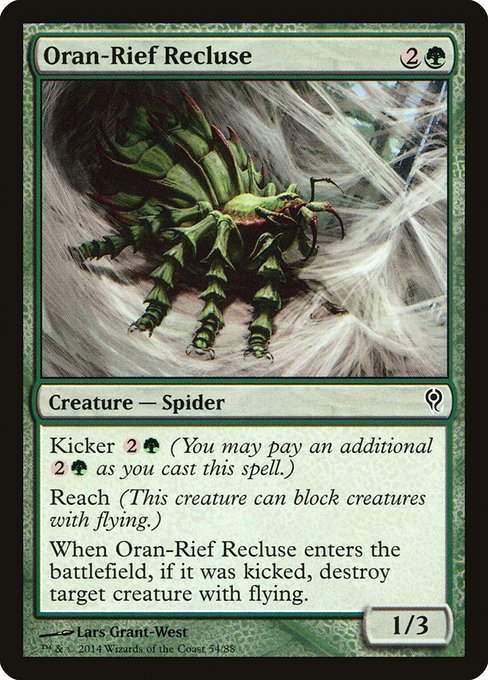
Image courtesy of Scryfall.com
Judicious Reach in a Four- or Five-Player Zone
Green has a long-running tradition of stomping its way through the early turns, but a smart green deck in multiplayer formats also leans on defense, tempo, and timely answers. Oran-Rief Recluse is a compact, cost-friendly piece that embodies that philosophy. With a base profile of a 1/3 spider for {2}{G}, it looks like a squarely ordinary body—until you notice the kicker ability. If you pay an extra {2}{G} as you cast it, this arachnid becomes a flying-destroyer on entry. That means your table faces a dual-threat: a sturdy body to block and an optional, on-entry removal spell for a flying threat. In multiway games, where flying creatures often represent the most immediate, end-game danger, that flexibility is gold 🧙♂️🔥.
Its reach keyword matters more than you might expect in Commander. A lot of decks lean on soarers—dragons, angels, and a rotating cast of utility fliers—to pressure life totals and pose inevitability. A single, well-timed kick can clear the skies and buy you a crucial breath of room to stabilize. The rug-pull here is that you don’t need to rely on a black or red removal suite; green’s got you covered with a single, well-timed swing of the bat. You’re not just playing a blocker; you’re adding a predictable, synergy-friendly answer to a volatile board state. And in three- to five-player circles, that “on-entry flyer removal” can become a recurring tempo engine if you’ve got the mana to keep it going a couple of times across the game. ⚔️
Strategic angles you’ll love at Commander tables
- Compression of cost versus payoff: Paying the kicker makes a card that otherwise slots into a defensive plan suddenly morph into a high-value removal spell. In EDH, where late-game mana often shows up in abundance, the extra cost becomes a feature rather than a burden. If your command zone produces extra glass-cannon turns, you get to transform a modest body into a decisive effect without losing tempo later.
- Blocking with purpose: The 1/3 statline isn’t flashy, but it’s nimble enough to hold down early fliers while you build up your own board or assemble a stabilizing engine. The real trick is to pair Oran-Rief Recluse with other green creatures that benefit from blockers or that rebalance after a removal swing—think of it as a micro-synergy layer that compounds as the game unfolds.
- Graveyard and recast considerations: In multiplayer, you’ll frequently encounter “swing first, ask questions later” combat phases. An early, kicked Recluse reduces the pressure on you to use hand-heavy removal and instead lets you pursue longer-game trajectories—ramping into bigger threats, or stacking meatier blockers behind it while the table chips away at each other. 🧙♂️
- Meta-aware play: If you’re in a table where flying threats loom large, this card becomes a dependable reply choice to keep the sky clear long enough to stabilize and pivot into a late-game plan. It’s not a panacea, but in the right build, it’s a steady, repeatable answer that doesn’t steal your focus from your own plan.
Deckbuilding notes for a green-centric or midrange EDH list
Oran-Rief Recluse shines when your mana rocks, tutors, and ramp are already humming. Consider these angles when slotting it into a deck:
- Ramp density: The kicker cost is nontrivial in the early turns, so a healthy green ramp package helps you reach that extra burst reliably. Cards like Cultivate, Kodama’s Reach, and various fetches can push you into a place where you can pay for the kicker and still keep pace with opponents who are accelerating faster than you.
- Protection and recursion: In multiplayer games, protection from removal and a plan to recur threats matter. Green staples like Eternal Witness or a red herring-protective suite can help you keep Recluse alive until you’re ready to deploy a second, even more decisive swing.
- Complementary fliers and blockers: While Recluse handles those pesky airborne threats, you can lean into other green and multicolored creatures that improve your defensive curve or force favorable trades. The combination creates a resilient board state that’s uncomfortable to breach for any table aiming for a quick kill.
- Strategic influence on combat math: In a crowded game, the presence of a reliable blocker is itself a strategic asset. It compels opponents to commit their air units more judiciously and can set up favorable blocks that stall or slow down a rival’s push.
“The sky isn’t safe while a green spider is patrolling the canopy.”
From a collectability and printing perspective, Oran-Rief Recluse sits in common rarity despite its potent EDH utility. Its card text is clean and accessible, making it a favorite for players building budget-friendly but resilient green commanders. And in a Duel Decks: Jace vs. Vraska frame, it’s a reminder that even older printings can remain relevant when the rules engine gives you the right moment to strike. The card’s evergreen flavor—grassy resilience with a tactical bite—serves as a quintessential example of how a single, well-timed ability can redefine a moment at the table. 💎
Bringing it all home with a cross-promotional nod
While you’re assembling your EDH toolkit, consider adding a touch of modern practicality to your desk space with the Neon Desk Neoprene Mouse Pad. The product is a brisk reminder that even a table can feel like a well-tuned play area, where every decision is a little more comfortable and every throw of the dice a little louder. If you’re curious about the pad, you can explore it here: Neon Desk Neoprene Mouse Pad — because even the best table talk benefits from a little glow-up. 🎨🧙♂️
More from our network
- https://crypto-acolytes.xyz/blog/post/master-skills-at-your-own-pace-with-free-online-courses/
- https://crypto-acolytes.xyz/blog/post/exploring-minecraft-dc-comics-mods-heroes-villains-builds/
- https://blog.digital-vault.xyz/blog/post/spectral-cloak-and-the-rise-of-modern-mtg-illustration-trends/
- https://blog.digital-vault.xyz/blog/post/evolutionary-escalation-advanced-sequencing-mastery-for-mtg/
- https://blog.digital-vault.xyz/blog/post/all-is-dust-advanced-mtg-stack-interactions-and-timing/